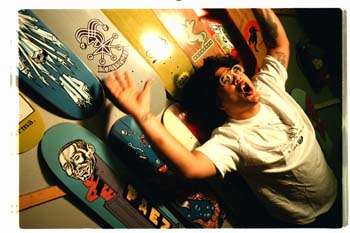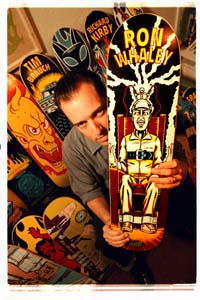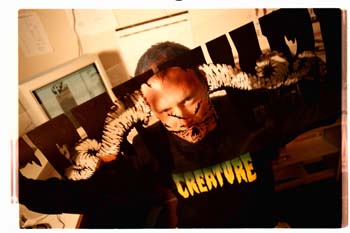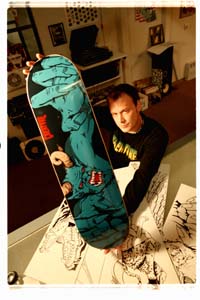![[MetroActive Arts]](/arts/gifs/art468.gif)
[ Arts Index | Metro Santa Cruz | MetroActive Central | Archives ]
Graphic Exposure
Extreme Graphics: Moish Brenman, art director for Consolidated Skateboards, throws himself into his work through art, activism and healthy doses of skating.
Local artists find a creative outlet in skateboarding graphics--and make a living doing what they love
By Mary Spicuzza
EVEN THE STAUNCHEST skate track opponent would be hard-pressed to prove that skateboarding isn't a creative sport. On any given afternoon at Westside's Derby Park, Santa Cruz's only existing skate park, local kids can be found grinding, flipping and inventing never-seen-before tricks and maneuvers.
But creativity is also found on the walls of Santa Cruz's many skate shops, where dozens of boards prove that the art of skateboarding reaches beyond the tricks of the sport. Their intricate graphics create a collage of skating subcultures and form a unique art gallery. Here daredevils laugh in the face of danger, coffee zombies wait for a fix, twisted creatures hover overhead. On skate decks, graffiti is seen as a valid form of street art rather than vandalism.
Many of the most striking boards inside these shops are made by Santa Cruz companies, particularly NHS--makers of Santa Cruz Skateboards, Creature and others--Consolidated Skateboards and Skater's Union.
Skate shop walls also prove that the most innovative graphics today aren't generated by guys in starched suits and stiff ties in marketing meetings, brainstorming about what sells to young people. Blending a passion for creative expression with a love and understanding of the sport, local skate artists contribute graphics that distinctly affect youth culture unlike any other art form.
JOHNNY MOJO, NHS' art director, lifts open the cover of his black sketchbook, whose papers appear tiny compared to the dozens of larger sheets of drawings stuffed between its covers. Most of Mojo's sketchbook sheets are bare, but the papers tucked inside are covered by impressive works, ranging from rough black-and-white sketches to detailed drawings rich with color.
Mojo (given name John Munnerlyn) flips through the pages--businessmen sipping martinis mingle with Hindu gods, a classic low-rider Impala cruises past flesh-eating Boy Scouts, bear-hunting scenes recall When Animals Attack. There's also the punk reunion at an old-folks home.
"[Skateboard art is] a creative field that's constantly changing," Mojo says. "It was a lot different 10 years ago when I started working here. The skateboarding industry has gone through a lot, and now it's back in the public eye."
Skateboarding began in California in the late 1950s and early '60s, when surfers who faced poor wave conditions started attaching roller-skate wheels to planks of wood. The first skateboarding craze didn't really start until the early 1970s, and even back then Santa Cruz led the way. In 1973, surfing buddies Richard Novak, Doug Haut and Jay Shuirman decided to make their board-manufacturing company an official corporation, and soon afterward they were traveling cross-country as NHS selling Santa Cruz Skateboards.
A cohesive history of skate graphics is slightly more elusive. When legendary local artist Jim Phillips started working as art director of NHS in 1974, skateboard graphics typically consisted of a straightforward, centralized logo--like the Santa Cruz Skateboards design that remains an icon of skateboard culture.
But in the mid-'80s, Phillips and a handful of other artists began taking over the entire deck of the board with their work. Many of Phillips' skate graphics from that time resemble his famous psychedelic rock & roll poster art that chronicled the era's music culture and reign of bands like Jefferson Starship and the Grateful Dead better than any other art form.
Phillips and his son, Jimbo, both have been extremely influential in skateboard and poster art in Santa Cruz, as well as throughout the country. Jimbo has drawn for Skater's Union, the zine Sessions and local record companies.
"I've been skating since I was 5," says Jimbo Phillips, a Santa Cruz native, "and I still love it."
Phillips the elder was working as art director when Mojo started freelancing for NHS in the late '80s. "It was great to work with Jim Phillips. ... It was like a dream come true," Mojo says. "He was always involved in doing stuff that had never been done before."
Mojo himself finds even more creative outlets doing acrylic paintings, creating found-art objects and designing T-shirts. He also draws music posters and album and CD covers for local bands and is the guitarist for the rockabilly band the Haywoods.
But most of his energy goes into skateboard graphics. "We're constantly evolving creatively with the graphics, keeping in tune with what's going on in the scene now, while keeping the Santa Cruz tradition of quality and innovation going," he says. "The bottom line is to keep it fun and interesting."
Guerrilla Theater
AS MOISH BRENMAN, Consolidated's art director, talks about the craft of skate art in his South of Laurel warehouse, it becomes obvious where he inherited his fighting spirit. A poster of Bruce Lee, poised with focused intensity, looks over Star Wars collectors figures ranging from Chewbacca to Darth Vadar.
"We're known as the guerrilla company," Brenman says proudly. "We hide up in the hills, swoop down on people and rearrange their set of thinking, then head back for the hills."
What does this mentality have to do with Consolidated's graphics? Just about everything. For instance, Consolidated's "Don't Do It" campaign, a retaliation that began when Nike Inc. launched its big-money drive to break into the skateboarding industry.
"Nike is a huge multimillion-dollar corporation that never gave a shit about skateboarding before," Brenman says. "The jocks who used to beat me up for skating wore Nikes ... and now Nike wants to be 'in' with skaters? Uh-uh. It's not gonna happen. We've had to fight and scramble and scrimp and save, and it wasn't so giant corporations could come along and buy their way into the industry."
Brenman's "Don't Do It" graphic drew attention to Nike, but it was really aimed at all large corporations trying to control an industry that, for the most part, is still dominated by small companies owned by the subculture supporting it. Within a year after Consolidated's campaign began, Nike stopped producing skateboards and pulled its sponsorship of the X Games, skateboarding's answer to the Olympics.
Consolidated Skateboards was started in 1991 by a group of four die-hard skaters, including Brenman, who originally moved to Santa Cruz to work with Mojo at NHS. "Mojo was a great teacher," Brenman says. "I have a lot of respect for him, and all of the artists there."
Consolidated's mission was to form a company with integrity, one owned and operated by young skaters. "Basically, we try to stay true to what our idea was from the beginning, which is not to be sellouts, to not go with the flow, to not just do whatever's trendy," Brenman says.
Mocking the trendy types, along with brainless jocks and corporate mass culture, is a favorite theme for many skate artists, as is poking fun at laws targeting skateboards--and those enforcing them. For example, NHS' "Skateboarding Is Not a Crime" logo can be seen on boards and bumper stickers across the country. And Mojo's "Donut Dreams," a graphic detailing an officer's fantasy of a late-night Dunkin' Donuts binge, illustrates skater frustrations.
Brenman's passion for the integrity of his work has also led him to get involved in Santa Cruz's quest for a skate park. He has worked on helping other towns develop skate tracks and even launched a series of boards with construction site-inspired graphics. Consolidated sent out each board in the series with a copy of "The Plan," the company's guide to helping young people build skate parks in their towns.
"We've had to fight so long for a park in Santa Cruz, we wouldn't let a couple of bad kids ruin it," Brenman says. "People are worried about noise and children yelling ... well, it's the exuberance of youth, I'm sorry if that offends you."
IT WAS Moish Brenman's passion for skating and art that first brought him to Santa Cruz. A friend of his became pro, joined the NHS-sponsored team of skaters and asked Brenman to do the graphics for his board. After Brenman created the graphics, Mojo invited him to come up from Santa Barbara and hang out in the art department. When one of the company's artists moved out of town, Brenman got a call from Mojo and started packing for Santa Cruz that day.
"They asked me how I'd feel about working there. ... I said, 'I'll see you Monday morning,' " Brenman smiles.
For Brenman, his move to Santa Cruz was an obvious choice. It allowed him to follow his passion. "I'm doing what I've always wanted to do," Brenman says. "I've been drawing since I can remember and skating since I was 10 years old."
Skateboarding's gone through countless cycles of popularity since that time, and skate artists find their work constantly changing. Yet while each company has a range of graphics available and changes with the times, both also strive to carve out a unique identity. That identity is defined by both the quality of the boards and the images decorating them.
NHS artist Demetrie Tyler holds up his notebook covered by a chart he calls the Progression of Skateboarding. An arrow points from a skull and cross-bones to a Nike symbol to a trumpet. And back to the skull.
"It's cyclical," Tyler laughs. "The Nike represents the 'rip-off stage,' when a lot of companies were just taking business logos and changing the lettering. The trumpet symbolizes companies which formed just to do artsy, jazzy graphics."
Mojo explains, "A lot of the art today is rebelling against old-school graphics. A lot of really cute graphics today are a reaction against the tough graphics, the skulls."
Brenman and the NHS artists remember companies that cropped up along the way and did whatever graphics were trendy at the time. Yet while many of them have shut down, NHS is celebrating its 25th anniversary, and Consolidated is nearly 10 years old.
Go Skate
ALTHOUGH LOCAL companies have been successful in keeping a strong image, the stereotype of the skater still has some catching up to do.
"On TV, the bad kid is always a skateboarder," Brenman says. "I'm sorry, but how many pro [skaters] are accused of violence, drugs, date rape, compared to athletes in other sports."
Similarly, the young local artists creating the graphics could hardly be deemed wayward slackers.
Jimbo Phillips divides his time doing skate and surf graphics, ad layouts, T-shirt designs and album covers. Demetrie Tyler of NHS is double-majoring in art and history at UC-Santa Cruz and works about 35 hours a week designing graphics for the company.
His co-worker Mark Whidmann moved from Fort Wayne, Indiana, where he worked in a skate shop and was employed as a full-time NHS sales representative for a year before joining the art department. Whidmann works throughout the week and skates most weekends, traveling to different skate parks around California.
When I ask if he worries about breaking his drawing fingers, he lifts his arms. "Naw, I've got metal plates already," Whidmann smiles.
And the collective hard work of local skate artists is obviously paying off.
"Santa Cruz Skateboards are just really good. They've been around a long time, and they've always been known for their quality," says 13-year-old skate aficionado Louis Opolinsky. Opolinsky, whose extensive collection of skateboards features both Consolidated and Santa Cruz Skateboards, says that board style and graphics are the most important factors to his skating buddies when choosing their decks.
Although board quality is key, many say it's the art that shapes identity more than anything else.
"In the end," Brenman says, "all you have to separate you from another company is your graphics."
[ Santa Cruz | MetroActive Central | Archives ]
Copyright © Metro Publishing Inc. Maintained by Boulevards New Media.
![]()

George Sakkestad Graphic Images
Graphic Images
Creature Feature: Mark Whidmann gets in touch with the darker side of skateboarding through his illustrations for NHS' Creature line. Skulls and Teddy Bears
Skulls and Teddy Bears
From the November 25-December 2, 1998 issue of Metro Santa Cruz.